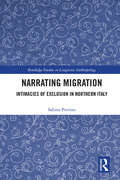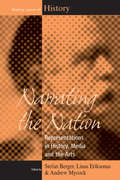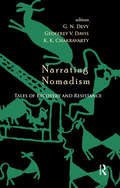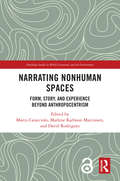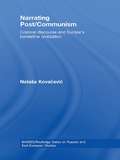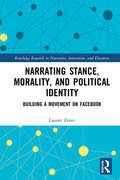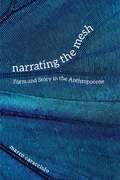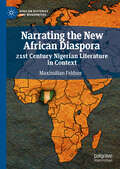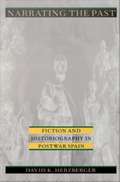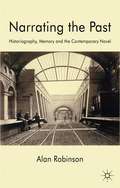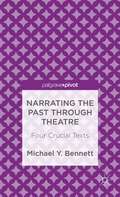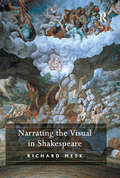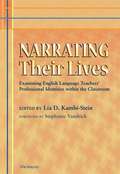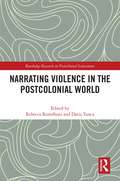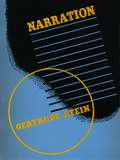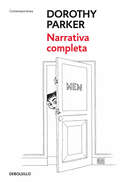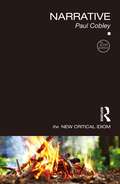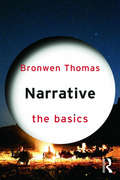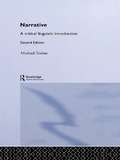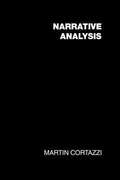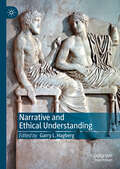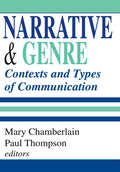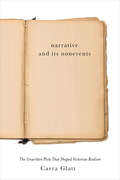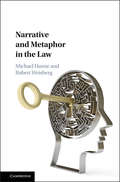- Table View
- List View
Narrating Migration: Intimacies of Exclusion in Northern Italy (Routledge Studies in Linguistic Anthropology)
by Sabina PerrinoThis book reflects on the myriad ways in which forms of exclusion and inclusion play out in narratives of migration, focusing on the case of Northern Italian narratives in today’s superdiverse Italy. Drawing on over a decade of the author’s fieldwork in the region, the volume examines the emergence of racialized language in conversations about migrants or migration issues in light of increasing recent migratory flows in the European Union, couched in the broader context of changing socio-political forces such as anti-immigration policies and nativist discourse in political communication in Italy. The book highlights case studies from everyday discourse in both villages and cities and at different levels of society to explore these "intimacies of exclusion," the varying degrees to which inclusion and exclusion manifest themselves in conversation on migration. The book also employs a narrative practice-based approach which considers storytelling as a more dynamic form of discourse, thus allowing for equally new ways of analyzing their content and impact. Offering a valuable contribution to the growing literature on narratives of migration, this volume is key reading for graduate students and scholars in linguistic anthropology, sociolinguistics, sociocultural anthropology, language and politics, and migration studies.
Narrating The Nation: Representations in History, Media and the Arts (Making Sense of History #11)
by Andrew Mycock Linas Eriksonas Stefan BergerA sustained and systematic study of the construction, erosion and reconstruction of national histories across a wide variety of states is highly topical and extremely relevant in the context of the accelerating processes of Europeanization and globalization. However, as demonstrated in this volume, histories have not, of course, only been written by professional historians. Drawing on studies from a number of different European nation states, the contributors to this volume present a systematic exploration, of the representation of the national paradigm. In doing so, they contextualize the European experience in a more global framework by providing comparative perspectives on the national histories in the Far East and North America. As such, they expose the complex variables and diverse actors that lie behind the narration of a nation.
Narrating Nomadism: Tales of Recovery and Resistance
by G. N. Devy; Geoffrey V. Davis; K. K. ChakravartyNarrating Nomadism provides an unflinching account of ethnic groups and nomadic communities across the world that were branded as ‘criminal’ during colonial times. It explores the tragic effect of the new identity imposed on them, the traumatic survival of these communities and cultures, and the creative expression of this experience in their arts and literature in the form of resistance. Presenting specific contexts and locations of cultural devastation in history, the volume traces colonial social imagination as such, showing how the grossly misperceived non-sedentary communities in the colonies were subjected to the mission of ‘settling’ them. The essays presented here document these alternative histories from perspectives ranging from literary criticism and art history to ethnography and socio-linguistics, highlighting in what ways different nomadic communities negotiate discrimination and challenge in contemporary times, while finding remarkable convergence in their local histories and collective testimonies.This anthology opens up a new area in postcolonial studies as well as cultural anthropology by bringing the viewpoint of marginalized communities and their cultural rights to bear upon history, society and culture. It places an activist’s ‘view from below’ at the centre of literary interpretation, engages with oral history more substantially than folklore studies usually do, and brings together several historical narratives hitherto unexplored. This will be essential for students of anthropology, sociology, cultural studies, history, linguistics, post-colonial studies, literature and tribal studies, as well as the general reader.
Narrating Nonhuman Spaces: Form, Story, and Experience Beyond Anthropocentrism (Routledge Studies in World Literatures and the Environment)
by Marco Caracciolo, Marlene Karlsson Marcussen, and David RodriguezRecent debates about the Anthropocene have prompted a re-negotiation of the relationship between human subjectivity and nonhuman matter within a wide range of disciplines. This collection builds on the assumption that our understanding of the nonhuman world is bound up with the experience of space: thinking about and with nonhuman spaces destabilizes human-scale assumptions. Literary form affords this kind of nonanthropocentric experience; one role of the critic in the Anthropocene is to foreground the function of space and description in challenging the conventional link between narrative and human (inter)subjectivity. Bringing together New Formalism, ecocriticism, and narrative theory, the included essays demonstrate that literature can transgress the strong and long-established boundary of the human frame that literary and narrative scholarship clings to. The focus is firmly on the contemporary but with strategic samplings in earlier cultural texts (the American transcendentalists, modernist fiction) that anticipate present-day anxieties about the nonhuman, while at the same time offering important conceptual tools for working through them.
Narrating Post/Communism: Colonial Discourse and Europe's Borderline Civilization (BASEES/Routledge Series on Russian and East European Studies)
by Natasa KovacevicThe transition of communist Eastern Europe to capitalist democracy post-1989 and in the aftermath of the Yugoslav wars has focused much scholarly attention - in history, political science and literature - on the fostering of new identities across Eastern European countries in the absence of the old communist social and ideological frameworks. This book examines an important, but hitherto largely neglected, part of this story: the ways in which the West has defined its own identity and ideals via the demonization of communist regimes and Eastern European cultures as a totalitarian, barbarian and Orientalist "other". It describes how old Orientalist prejudices resurfaced during the Cold War period, and argues that the establishment of this discourse helped to justify transitions of Eastern European societies to market capitalism and liberal democracy, suppressing Eastern Europe’s communist histories and legacies, whilst perpetuating its dependence on the West as a source of its own sense of identity. It argues that this process of Orientalization was reinforced by the literary narratives of Eastern European and Russian anti-communist dissidents and exiles, including Vladimir Nabokov, Czeslaw Milosz and Milan Kundera, in their attempts to present themselves as native, Eastern European experts and also emancipate themselves – and their homelands – as civilized, enlightened and Westernized. It goes on to suggest that the greatest potential for recognizing and overcoming this self-Orientalization lies in post-communist literary and visual narratives, with their themes of disappointment in the social, economic, or political changes brought on by the transitions, challenge of the unequal discursive power in East-West dialogues where the East is positioned as a disciple or a mimic of the West, and the various guises of nostalgia for communism.
Narrating Stance, Morality, and Political Identity: Building a Movement on Facebook (Routledge Research in Narrative, Interaction, and Discourse)
by Lauren ZentzThis book offers unique insights into the use of Facebook after the 2016 US presidential election, interrogating how users in private groups draw on individual experiences in movement building and identity construction while also critically reflecting on ethnographic practices around social media. The volume draws on the author’s own involvement in a specific Facebook group focused around activism and community organizing in Texas following the 2016 US presidential election. Chapters draw on the frameworks of "small stories" and "stance" to unpack the ways in which group members use parts of their individual stories to signal beliefs to others, present themselves in relation to the group, and signal virtues of moral authority on various pressing political issues. Building on these analyses, Zentz goes on to address ways in which the scales of politics are being navigated and modified at the grassroots level in our highly networked world. This book contributes to ongoing conversations about the realities of internet use within linguistic anthropology and new media studies, and how researchers might seek to account for social media use and access to this data as these technologies develop further. This book is key reading for students and scholars in linguistic anthropology, media studies, and activism and social movement studies.
Narrating the Crusades
by Lee ManionIn Narrating the Crusades, Lee Manion examines crusading's narrative-generating power as it is reflected in English literature from c. 1300 to 1604. By synthesizing key features of crusade discourse into one paradigm, this book identifies and analyzes the kinds of stories crusading produced in England, uncovering new evidence for literary and historical research as well as genre studies. Surveying medieval romances including Richard Cœur de Lion, Sir Isumbras, Octavian, and The Sowdone of Babylone alongside historical practices, chronicles, and treatises, this study shows how different forms of crusading literature address cultural concerns about collective and private action. These insights extend to early modern writing, including Spenser's Faerie Queene, Marlowe's Tamburlaine, and Shakespeare's Othello, providing a richer understanding of how crusading's narrative shaped the beginning of the modern era. This first full-length examination of English crusading literature will be an essential resource for the study of crusading in literary and historical contexts.
Narrating the Mesh: Form and Story in the Anthropocene (Under the Sign of Nature)
by Marco CaraccioloA hierarchical model of human societies’ relations with the natural world is at the root of today’s climate crisis; Narrating the Mesh contends that narrative form is instrumental in countering this ideology. Drawing inspiration from Timothy Morton’s concept of the "mesh" as a metaphor for the human-nonhuman relationship in the face of climate change, Marco Caracciolo investigates how narratives in genres such as the novel and the short story employ formal devices to effectively channel the entanglement of human communities and nonhuman phenomena.How can narrative undermine linearity in order to reject notions of unlimited technological progress and economic growth? What does it mean to say that nonhuman materials and processes—from contaminated landscapes to natural evolution—can become characters in stories? And, conversely, how can narrative trace the rising awareness of climate change in the thick of human characters’ mental activities? These are some of the questions Narrating the Mesh addresses by engaging with contemporary works by Ted Chiang, Emily St. John Mandel, Richard Powers, Jeff VanderMeer, Jeanette Winterson, and many others. Entering interdisciplinary debates on narrative and the Anthropocene, this book explores how stories can bridge the gap between scientific models of the climate and the human-scale world of everyday experience, powerfully illustrating the complexity of the ecological crisis at multiple levels.
Narrating the New African Diaspora: 21st Century Nigerian Literature In Context (African Histories and Modernities)
by Maximilian FeldnerThis book provides the first comprehensive survey and collection of Nigerian diaspora literature, offering readings of novelists such as Chimamanda Ngozi Adichie, Sefi Atta, Helon Habila, Helen Oyeyemi, Taiye Selasi, Chika Unigwe, Chris Abani, and Ike Oguine. As members of the new African diaspora, their literature captures experiences of recent Nigerian migration to the United States and the United Kingdom. Examining representative novels, such as Adichie’s Half of a Yellow Sun and Americanah, Habila’s Waiting for an Angel, Abani’s GraceLand, and Oyeyemi’s The Icarus Girl, the book discusses these novels’ literary and narrative methods and provides detailed analyses of two of the most common themes: depictions of migratory experiences and representations of Nigeria. Placing the novels in their relevant historical, sociological, philosophical, and theoretical contexts, Narrating the New African Diaspora presents an insightful study of current anglophone Nigerian narrative literature.
Narrating the Past: Fiction and Historiography in Postwar Spain
by David K. HerzbergerThe relationship between fiction and historiography in Francoist Spain (1939-1975) is a contentious one. The intricacies of this relationship, in which fiction works to subvert the regime's authority to write the past, are the focus of David K. Herzberger's book. The narrative and rhetorical strategies of historical discourse figure in both the fiction and historiography of postwar Spain. Herzberger analyzes these strategies, identifying the structures and vocabularies they use to frame the past and endow it with particular meanings. He shows how Francoist historians sought to affirm the historical necessity of Franco by linking the regime to a heroic and Christian past, while several types of postwar fiction--such as social realism, the novel of memory, and postmodern novels--created a voice of opposition to this practice. Focusing on the concept of writing history that these opposing strategies convey, Herzberger discloses the layering of truth and meaning that lies at the heart of postwar Spanish narrative from the early 1940s to the fall of Franco. His study clearly reveals how the novel in postwar Spain became a crucial form of dissent from the past as it was conceived and used by the State. Making a decisive intervention in the debate about the ways in which narration determines both the meaning and truth of history and fiction, Narrating the Past will be of special interest to students and scholars of the politics, history, and literature of twentieth-century Spain.
Narrating the Past
by Alan RobinsonIn recent years controversy has surrounded the narrative turn in history and the historical turn in fiction. This book clarifies what is at stake, tracing connections between historiography and life-writing, arguing that the challenges posed in representing the past illuminate issues which are central to all literary narrative.
Narrating the Past through Theatre
by Michael Y. BennettThis cutting-edge title explores how narrating the past both conflicts and creates an interesting relationship with drama's 'continuing present' that arcs towards an unpredictable future. Theatre both brings the past alive and also fixes it, but through the performance process, allowing the past to be molded for future (not-yet-existent) audiences.
Narrating the Visual in Shakespeare
by Richard MeekThis book examines Shakespeare's fascination with the art of narrative and the visuality of language. Richard Meek complicates our conception of Shakespeare as either a 'man of the theatre' or a 'literary dramatist', suggesting ways in which his works themselves debate the question of text versus performance. Beginning with an exploration of the pictorialism of Shakespeare's narrative poems, the book goes on to examine several moments in Shakespeare's dramatic works when characters break off the action to describe an absent, 'offstage' event, place or work of art. Meek argues that Shakespeare does not simply prioritise drama over other forms of representation, but rather that he repeatedly exploits the interplay between different types of mimesis - narrative, dramatic and pictorial - in order to beguile his audiences and readers. Setting Shakespeare's works in their literary and rhetorical contexts, and engaging with contemporary literary theory, the book offers new readings of Venus and Adonis, The Rape of Lucrece, Hamlet, King Lear and The Winter's Tale. The book will be of particular relevance to readers interested in the relationship between verbal and visual art, theories of representation and mimesis, Renaissance literary and rhetorical culture, and debates regarding Shakespeare's status as a literary dramatist.
Narrating Their Lives: Examining English Language Teachers' Professional Identities Within The Classroom
by Lia Kamhi-Stein Stephanie Vandrick“…a groundbreaking book that will…engage, inform, and connect with present and future teachers and teacher educators. ” ---Stephanie Vandrick, Foreword to Narrating Their Lives The field of TESOL has called attention to the ways that the issues of race and ethnicity, language status and power, and cultural background affect second language learners’ identities and, to some degree, those of teachers. In Narrating Their Lives, Kamhi-Stein examines the process of identity construction of classroom teachers so as to make connections between their personal and professional identities and their instructional practices. To do that, she has selected six autobiographical narratives from teachers who were once part of her TESL 570 (Educational Sociolinguistics) class in the MA TESOL program at California State University, Los Angeles. These six narratives cover a surprisingly wide range of identity issues but also touch on broader instructional themes that are part of teacher education programs. Because of the reflective nature of the narratives—with the teachers using their stories to better understand how their experiences shape what they do in the classroom—this volume includes provocative chapter-opening and reflective chapter-closing questions. An informative discussion of the autobiographical narrative assignment and the TESL 570 course (including supplemental course readings and assessment criteria) is also included.
Narrating Violence in the Postcolonial World (Routledge Research in Postcolonial Literatures)
by Rebecca Romdhani Daria TuncaThis book examines representations of violence across the postcolonial world—from the Americas to Australia—in novels, short stories, plays, and films. The chapters move from what appear to be interpersonal instances of violence to communal conflicts such as civil war, showing how these acts of violence are specifically rooted in colonial forms of abuse and oppression but constantly move and morph. Taking its cue from theories in such fields as postcolonial, violence, gender, and trauma studies, the book thus shows that violence is slippery in form, but also fluid in nature, so that one must trace its movement across time and space to understand even a single instance of it. When analysing such forms and trajectories of violence in postcolonial creative writing and films, the contributors critically examine the ethical issues involved in narrating abuse, depicting violated bodies, and presenting romanticized resolutions that may conceal other forms of violence.
Narration: Four Lectures
by Gertrude SteinNewly famous in the wake of the publication of her groundbreaking Autobiography of Alice B. Toklas, Gertrude Stein delivered her Narration lectures to packed audiences at the University of Chicago in 1935. Stein had not been back to her home country since departing for France in 1903, and her remarks reflect on the changes in American culture after thirty years abroad.In Stein’s trademark experimental prose, Narration reveals the legendary writer’s thoughts about the energy and mobility of the American people, the effect of modernism on literary form, the nature of history and its recording, and the inventiveness of the English language—in particular, its American variant. Stein also discusses her ambivalence toward her own literary fame as well as the destabilizing effect that notoriety had on her daily life. Restored to print for a new generation of readers to discover, these vital lectures will delight students and scholars of modernism and twentieth-century literature.“Narration is a treasure waiting to be rediscovered and to be pirated by jolly marauders of sparkling texts.”—Catharine Stimpson, NYU
Narrativa completa
by Dorothy ParkerPor primera vez en castellano la narrativa completa de Dorothy Parker, una señora que supo vivir y escribir a la altura de su talento. Dorothy Parker escribió una vez que lo suyo era tomarse un Martini, dos como mucho. Después del tercero, ya estaba debajo de la mesa, y al cuarto... debajo de su anfitrión. Con esas premisas, y haciendo gala de un humor que arañaba los buenos hábitos de la burguesía de entonces, cabe entender que la misma Dorothy se convirtiese en personaje, y que su obra se leyera a menudo como la alegre guarnición de una vida dedicada al chiste ingenioso. Los años fueron pasando, y el tiempo ha revelado que esta protagonista indiscutible de las tertulias más animadas del Nueva York de entreguerras, esposa infiel y amante solícita, fue además una escritora de primer orden, capaz de resumir en pocas páginas la hipocresía de una sociedad que crecía a la sombra de un dinero recién estrenado y de unas costumbres que se caían de viejas. Así lo muestran las mujeres y los hombres que deambulan por sus cuentos, seres patéticos que lloran en habitaciones exquisitamente decoradas, flirtean con un empeño digno de mejores causas, o ríen sin ganas en la barra de un bar para olvidar que alguna vez fueron felices. Es más, basta con acercarnos un poco a esas parejas desesperadas y tiernas para darnos cuenta de que la prosa de Dorothy Parker no ha muerto. Al contrario, su protesta es más actual que nunca, su sonrisa aún nos acompaña, su amor por Nueva York cala hondo, y su ironía es el mejor de los regalos en una época de tanta perplejidad. Reseña:«La posteridad ha obrado en favor de una autora que, al menos en lo que a la sensibilidad femenina se refiere, fue una auténtica visionaria.»El Mundo «La Narrativa completa de Dorothy Parker es un acercamiento sin preámbulos al universo rompedor, rebelde y amante de Nueva York, y a los claroscuros de la escritora más importante e infravalorada de la época.»Cosuki Naru, Mycelebrityskin.net
Narrative: A Critical Linguistic Introduction (The New Critical Idiom)
by Paul CobleyHuman beings have constantly told stories, presented events and placed the world into narrative form. This activity suggests a very basic way of looking at the world, yet, this book argues, even the most seemingly simple of stories is embedded in a complex network of relations. Paul Cobley traces these relations, considering the ways in which humans have employed narrative over the centuries to ‘re-present’ time, space and identity. This second, revised and fully updated edition of the successful guidebook to narrative covers a range of narrative forms and their historical development from early oral and literate forms through to contemporary digital media, encompassing Hellenic and Hebraic foundations, the rise of the novel, realist representations, narratives of imperialism, modernism, cinema, postmodernism and new technologies. A final chapter reviews the way that narrative theory in the last decade has re-orientated definitions of narrative. Written in a clear, engaging style and featuring an extensive glossary of terms, this is the essential introduction to the history and theory of narrative.
Narrative: Stories And Storytelling In The Digital Age (The Basics)
by Bronwen ThomasProviding an up-to-date and accessible overview of the essentials of narrative theory, Narrative: The Basics guides the reader through the major approaches to the study of narrative, using contemporary examples from a wide range of narrative forms to answer key questions including: What is narrative? What are the "universals" of narrative? What is the relationship between narrative and ideology? Does the reader have a role in narrative? Has the digital age brought radically new forms of narrative? Each chapter introduces key theoretical terms, providing thinking points and suggestions for further study. With an emphasis on applying theory to example studies, it is an ideal introduction to the current study of narrative.
Narrative: A Critical Linguistic Introduction (Interface Ser.)
by Michael ToolanThis classic text has been substantially rewritten. Narrative explores a range of written, spoken, literary and non-literary narratives. It shows what systematic attention to language can reveal about the narratives themselves, their tellers, and those to whom they are addressed.New material includes sections on gendered narrative, film narrative and a discussion of ways in which the internet and global television are changing conceptions of narrative.
Narrative Analysis: Social Research and Educational Studies Series
by Martin CortazziThe book examines models of narrative analysis currently proposed in linguistics, sociology, psycology, anthropology and literature and applies insights from these disciplines to the study of teachers' narratives. <P><P>The author proposes an alternative approach to studying narratives which is then applied to original data, demonstrating how narrative analysis can be used to study primary teachers' perceptions of their work.
Narrative and Ethical Understanding
by Garry L. HagbergThere has been a steady stream of articles written on the relations between ethics and the interpretation of literature, but there remains a need for a book that both introduces and significantly contributes to the field – particularly one that shows how we can think more openly and creatively about the multiform powers of ethical narrative by considering ethically significant literature. This volume offers an analytically acute and culturally rich way of understanding how it is that we can productively think philosophically about the narrative structures that describe our ethical lives and what kind of distinctive conceptual, and in some cases personal, progress we can make by doing so. Given the extremely widespread interest in ethical issues, this volume will strike resonant chords far and wide on arrival, while offering something new in bringing together the study of long-form narrative, the language of moral psychology, and detailed literary case studies. Given the vast expansion of narrative studies in recent years, the time for just such a volume is right.
Narrative and Genre: Contexts and Types of Communication (Routledge Studies In Memory And Narrative Ser. #Vol. 1)
by Mary Chamberlain Paul ThompsonAny life story, whether a written autobiography or an oral testimony, is shaped not only by the reworkings of experience through memory and re-evaluation, but also by art. Any communication has to use shared conventions not only of language itself, but also the more complex expectations of ""genre,"" the forms expected within a given context and type of communication. This collection of essays by international academics draws on a wide range of disciplines in the social sciences and the humanities to examine how far the expectations and forms of genre shape different kinds of autobiography and influence what messages they can convey. After investigating the problem of genre definition, and tracing the evolution of genre as a concept, contributors explore such issues as: How far can we argue that what people narrate in their autobiographical stories is selected and shaped by the repertoire of genre available to them? To what extent is oral autobiography shaped by its social and cultural context? What is the relationship between autobiographical sources and the ethnographer? Narrative and Genre presents exciting new debates in an emerging field and will encourage international and interdisciplinary discussion. Its authors and contributors are scholars from the fields of anthropology, cultural studies, literary analysis, psychology, psychoanalysis, social history, and sociology.
Narrative and Its Nonevents: The Unwritten Plots That Shaped Victorian Realism (Victorian Literature and Culture Series)
by Carra GlattThis book is about what does not happen in the Victorian novel. The description may sound absurd, yet consideration of alternatives to a given state of affairs is crucial to our understanding of a novel. Plot emerges out of the gradual elimination of possibilities, from the revelation, on the first page of a work, that we are in nineteenth-century London and not sixteenth-century Paris, to the final disclosure that Pip returns home too late to marry Biddy but is now free to pursue his lost love Estella.Through careful examination of the plots of such classics as Charles Dickens’s Great Expectations, Charlotte Brontë’s Villette, Wilkie Collins’s The Moonstone, Jane Austen’s Pride and Prejudice, Henry James’s The Ambassadors, Elizabeth Gaskell’s Mary Barton, and others, Glatt argues for the central role of these "unwritten plots" in Victorian narrative construction. Abandoning the allegorical mode—in which characters are bound by fixed identities to reach a predetermined conclusion—and turning away from classical and historical plots with outcomes already known to audiences, the realist novel of the Victorian era was designed to simulate the openness and uncertainty of ordinary human experience. We are invested in these stories of David Copperfield or Elizabeth Bennet or Lucy Snowe in part because we cannot be entirely sure how those stories will end. As Glatt demonstrates, the Victorian novel is characterized by a proliferation of possibilities.
Narrative and Metaphor in the Law
by Robert Weisberg Michael HanneIt has long been recognized that court trials, both criminal and civil, in the common law system, operate around pairs of competing narratives told by opposing advocates. In recent years, however, it has increasingly been argued that narrative flows in many directions and through every form of legal theory and practice. Interest in the part played by metaphor in the law, including metaphors for the law, and for many standard concepts in legal practice, has also been strong, though research under the metaphor banner has been much more fragmentary. In this book, for the first time, a distinguished group of legal scholars, collaborating with specialists from cognitive theory, journalism, rhetoric, social psychology, criminology, and legal activism, explore how narrative and metaphor are both vital to the legal process. Together, they examine topics including concepts of law, legal persuasion, human rights law, gender in the law, innovations in legal thinking, legal activism, creative work around the law, and public debate around crime and punishment.
